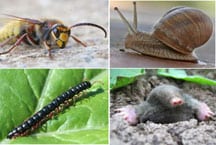This expert guide will help you keep your home pest-free. Learn about the different ways to get rid of insects and pests that can infest homes.
Are battalions of bugs harvesting your house, feasting on your fabrics, or gobbling up your garden? When left alone, ants, aphids, termites, and other bothersome bugs can wreak havoc. So how do you get the bugs out—and keep them out?
Generally speaking, opt for the least toxic method that will solve the problem. Considering that the more effective and powerful insecticides can be dangerous and their long-term effects on our bodies and environment are unknown, prudent avoidance is the best policy. Also, most chemical pesticides wipe out the good with the bad, which may ultimately cause some types of infestation problems to worsen.
Here are a few helpful steps you can take:
Caulk and seal. Your first line of defense against bugs in your house should be to block access routes. Armed with a caulking gun, seal up cracks and crannies where bugs might enter, including openings around pipes and heating ducts. Also weather-strip doors and windows.
Fix and clean. Eliminate areas that encourage or foster termites and other insects, especially damp areas or places where drainage is poor. Repair any rotted wood. Be sure no parts of your house are in direct contact with the ground. Clean up and clear out areas that provide safe harbor for insects. Store food, liquids, and garbage in sealed containers.
Look for problems. Early detection can be half the battle. Most insects increase their numbers rapidly, so getting them before they multiply lessens the potential damage and needed remedies. If you suspect that termites or other house-eating bugs may be present in your home, don’t wait for the problem to get worse. Though some termites take years to damage a house, others—notably Formosan termites—can devour tremendous amounts of wood in a matter of months.
Professional inspection. With termites, your best bet is to call a pest inspector. Detecting the location and extent of termites and other bugs within the structure of a house is something of an art. Inspectors use a combination of probing, tapping, listening, and looking. Some may use fiber-optic scopes that can peer inside a wall. Some even use dogs that can sniff out the presence of termites inside walls. After finding insect infestation, a good inspector will recommend one or more options for eradicating the bugs and discuss the pros and cons of each. If you’ve caught the problem early, the solution may be relatively simple and inexpensive.
Boric acid, a powder that’s relatively safe to use indoors, will treat small, localized infestations of ants, silverfish, firebrats, fleas, and cockroaches. Be sure to follow the label directions precisely.
Chlorpyrifos, a chemical pesticide that’s available in powdered (as well as liquid) form, will kill carpenter ants, powderpost beetles, carpet beetles, and a variety of other insects listed on the label.
A strong spray from a hose may be enough to dislodge aphids, whiteflies, mites, or other plant-sucking insects.
Insect soap spray, commercially available, penetrates the waxy covering on many plant-sucking insects, suffocating them or attacking their nervous systems. Make your own by mixing 3 to 6 tablespoons of dishwashing soap with 1 gallon of water, but test for damage on a part of the plant before beginning the full treatment.
Organic pesticides are necessary for killing stubborn infestations of plant-sucking insects or heartier plant chewers such as beetles or caterpillars. Deadly to bugs but considered safe for humans, these are not quite as effective or long-lasting as chemical pesticides, but they’re safer to use. They generally must be reapplied every 7 to 10 days. Most of these are plant extracts deadly to bugs. The category includes pyrethrum, rotenone, sabadilla, BT (bacillus thuringiensis), neem, and horticultural oils.
Chemical pesticides are deeper into the hit list for plant bugs—they’re more powerful and longer lasting. The first choice in this category would be systemics that treat from the ground up (but don’t use them around children or pets). The least toxic chemical pesticides are generally considered to include malathion, chlorpyrifos, diazinon, and carbaryl (Sevin). Carbaryl will kill honeybees, so be careful with it.








 Don Vandervort writes or edits every article at HomeTips. Don has:
Don Vandervort writes or edits every article at HomeTips. Don has:
